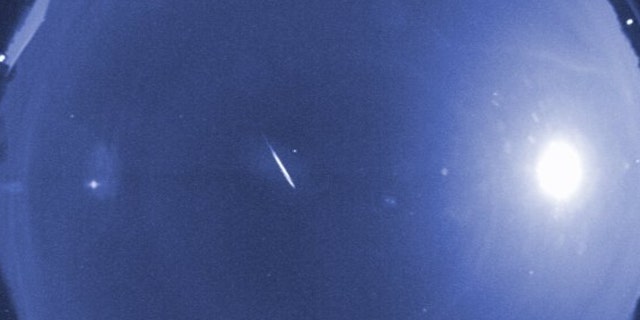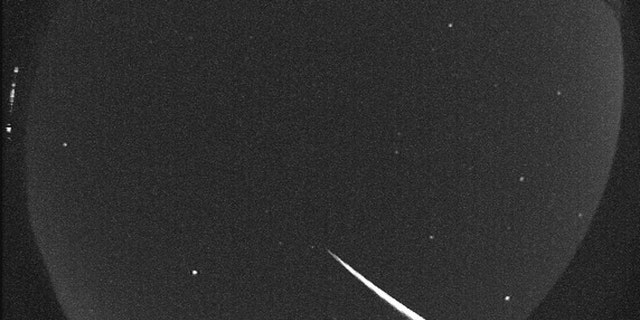The Quadrantid meteor shower, the first of the year and one of the best displays, was peaking Wednesday morning amid a bright moon and cloudy weather conditions.
The full moon will occur on Friday, bringing bright moonlight in the days ahead.
According to Space.com, the moon’s shine has made it hard to see all but the very brightest meteors this year, which are most visible before the break of dawn.
Another obstacle is active weather this week over much of the U.S.
WALTER CUNNINGHAM, LAST SURVIVING NASA APOLLO 7 ASTRONAUT, DIES AT 90: ‘TRUE HERO’
FOX Weather reported Tuesday that parts of western Texas could have a shot at a clear view.

False-color image of a rare early Quadrantid, captured by a NASA meteor camera in 2010.
((NASA/MEO/B. Cooke) )
According to NASA, the Quadrantids originate from the asteroid 2003 EH1.
The shower radiates from the northeast corner of the constellation Boötes, originally known as “Quadrans Muralis.”

The Quadrantid meteor shower is seen above a park in Yantai, East China’s Shandong Province, in the early morning of Jan. 4, 2022.
((Photo credit should read Yu Liangyi / Costfoto/Future Publishing via Getty Images))
HUBBLE SPACE TELESCOPE IMAGE CAPTURES ‘GLITTERING SWARM’ OF STARS ABOUT 28,000 LIGHT-YEARS AWAY
Beginning in late December and running through Jan. 16, the Quadrantids peak for just a few hours.
As many as 200 Quadrantid meteors – and as few as 60 – can be seen per hour under perfect conditions.

NASA’s All Sky cameras captured this image of a Quadrantid meteor overnight, the meteor was moving at 93,000 miles per hour. This one-inch diameter member of the Quadrantid meteor shower leaves a brilliant streak in the north Georgia skies before burning up 44 miles above Earth’s surface.
(NASA’s All Sky cameras)
They are also known for their bright fireball meteors and are best viewed in the Northern Hemisphere.
CLICK HERE TO GET THE FOX NEWS APP
Next year is expected to be a better viewing experience, but skywatchers can see the α-Centaurid meteor shower peak just before Valentine’s Day.
